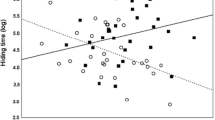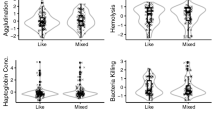Abstract
Activation of the immune system in insects has been shown to be costly in the laboratory setting, but experimental studies in the field are lacking. The costs of immunity in the wild may be different to those in the laboratory because animals in the wild are simultaneously subjected to a suite of selective agents. We have measured the costs of immune system activation in a wild population of the territorial damselfly Calopteryx splendens. Immune-challenged males were found to be less likely to be territorial and had lower overall survival rates than control or sham-manipulated males. Because territorial males have a higher mating success than nonterritorial males, this result suggests that immune-challenged males are also likely to suffer reduced mating success. However, the activation of the immune system as such did not increase predation risk; this occurred due to a combination of the former with a reduced territory-holding potential. As such, immune-challenged males not holding a territory were most susceptible to predation by birds. The size of the wing spots, a known sexually selected male trait, predicted territorial behaviour in control and sham-manipulated males, but not in immune-challenged males. Our data show that immune system activation can have several costs acting in unison and that ubiquitous ecological interactions, such as predation, may affect trade-offs between immunity and other life history traits.



Similar content being viewed by others
References
Armitage SAO, Thompson JJW, Rolff J, Siva-Jothy MT (2003) Examining costs of induced and constitutive immune investment in Tenebrio molitor. J Evol Biol 16:1038–1044
Askew RR (1988) The dragonflies of Europe. Harley Books, London
Contreras-Garduño J, Canales-Lazcano J, Córdoba-Aguilar A (2006) Wing pigmentation, immune ability, fat reserves and territorial status in males of the rubyspot damselfly, Hetaerina americana. J Ethol 24:165–173
Contreras-Garduño J, Córdoba-Aguilar A, Lanz-Mendoza H, Cordero-Rivera A (2009) Territorial behaviour and immunity are mediated by juvenile hormone: the physiological basis of honest signalling? Funct Ecol 23:157–163. doi:10.1111/j.1365-2435.2008.01485.x
Corbet PS (1999) Dragonflies: behaviour and ecology of odonata. Harley Books, Essex
Elliot SL, Blanford S, Thomas MB (2002) Host–pathogen interactions in a varying environment: temperature, behavioural fever and fitness. Proc R Soc Lond B 269:1599–1607. doi:10.1098/rspb.2002.2067
Forbes MR, Muma KE, Smith BP (1999) Parasitism of Sympetrum dragonflies by Arrenurus planus mites: maintenance of resistance particular to one species. Int J Parasitol 29:991–999
Grether GF (1996) Sexual selection and survival selection on wing coloration and body size in the rubyspot damselfly Hetaerina americana. Evolution 50:1939–1948
Hanssen SA, Hasselquist D, Folstad I, Erikstad KE (2004) Costs of immunity: immune responsiveness reduces survival in a vertebrate. Proc R Soc Lond B 271:925–930
Ilmonen P, Taarna T, Hasselquist D (2000) Experimentally activated immune defence in female pied flycatchers results in reduced breeding success. Proc R Soc Lond B 267:665–670
Koskimäki J, Rantala MJ, Taskinen J, Tynkkynen K, Suhonen J (2004) Immunocompetence and resource holding potential in the damselfly, Calopteryx virgo L. Behav Ecol 15:169–173
Marden JH, Cobb JR (2004) Territorial and mating success of dragonflies that vary in muscle power output and presence of gregarine gut parasites. Anim Behav 68:857–865
Marden JH, Waage JK (1990) Escalated damselfly territorial contests are energetic wars of attrition. Anim Behav 39:954–959
Moret Y, Schmid-Hempel P (2000) Survival for immunity: the price of immune system activation for bumblebee workers. Science 290:1166–1168. doi:10.1126/science.290.5494.1166
Plaistow S, Siva-Jothy MT (1996) Energetic constraints and male mate-securing tactics in the damselfly Calopteryx splendens xanthostoma (Charpentier). Proc R Soc Lond B 263:1233–1238
Raberg L, Nilsson JA, Ilmonen P, Stjernman M, Hasselquist D (2000) The cost of an immune response: vaccination reduces parental effort. Ecol Lett 3:382–386
Raihani G, Serrano-Meneses MA, Córdoba-Aguilar A (2008) Male mating tactics in the American rubyspot damselfly: territoriality, nonterritoriality and switching behaviour. Anim Behav 75:1851–1860
Rantala MJ, Roff DA (2007) Inbreeding and extreme outbreeding cause sex differences in immune defence and life history traits in Epirrita autumnata. Heredity 98:329–336
Rantala MJ, Koskimäki J, Taskinen J, Tynkkynen K, Suhonen J (2000) Immunocompetence, developmental stability and wingspot size in the damselfly Calopteryx splendens L. Proc R Soc Lond B 267:2453–2457
Rantala MJ, Hovi M, Korkeamäki E, Suhonen J (2001) No trade-off between the size and timing of emergence in the damselfly, Calopteryx virgo L. Ann Zool Fenn 38:117–122
Rantala MJ, Kortet R, Kotiaho JS, Vainikka A, Suhonen J (2003) Condition dependence of pheromones and immune function in the grain beetle Tenebrio molitor. Funct Ecol 17:534–540
Rolff J, Siva-Jothy MT (2002) Copulation corrupts immunity: a mechanism for a cost of mating in insects. Proc Natl Acad Sci USA 99:9916–9918. doi:10.1073/pnas.152271999
Rolff J, Siva-Jothy MT (2003) Invertebrate ecological immunology. Science 301:472–475
Rolff J, Siva-Jothy MT (2004) Selection on insect immunity in the wild. Proc R Soc Lond B 217:2157–2160. doi:10.1098/rspb.2004.2859
Sadd B, Holman L, Armitage H, Lock F, Marland R, Siva-Jothy MT (2006) Modulation of sexual signalling by immune-challenged male mealworm beetles (Tenebrio molitor, L.): evidence for terminal investment and dishonesty. J Evol Biol 19:321–325. doi:10.1111/j.1420-9101.2005.01062.x
Schmid-Hempel P (2003) Immunology and evolution of infectious disease. Science 300:254
Serrano-Meneses MA, Córdoba-Aguilar A, Mendez V, Layen SJ, Szekely T (2007) Sexual size dimorphism in the American rubyspot: male body size predicts male competition and mating success. Anim Behav 73:987–997
Siva-Jothy MT (1999) Male wing pigmentation may affect reproductive success via female choice in a calopterygid damselfly (Zygoptera). Behaviour 136:1365–1377
Siva-Jothy MT (2000) A mechanistic link between parasite resistance and expression of a sexually selected trait in a damselfly. Proc R Soc Lond B 267:2523–2527. doi:10.1098/rspb.2000.1315
Siva-Jothy MT, Gibbons DW, Pain D (1995) Female oviposition-site preference and egg hatching success in the damselfly Calopteryx splendens xanthostoma. Behav Ecol Sociobiol 37:39–44
Suhonen J, Rantala MJ, Honkavaara J (2008) Territoriality in odonates. In: Córdoba-Aguilar A (ed) Dragonflies and damselflies: model organisms for ecological and evolutionary research. Oxford University Press, Oxford, pp 203–217
Suhonen J, Honkavaara J, Rantala MJ (2010) Activation of the immune system promotes insect dispersal in the wild. Oecologia 162:541–547. doi:10.1007/s00442-009-1470-2
Svensson EI, Friberg M (2007) Selective predation on wing morphology in sympatric damselflies. Am Nat 170:101–111
Toivanen T, Rantala MJ, Suhonen J (2009) Influence of alternative mating tactics on predation risk in the damselfly Calopteryx virgo. Can J Zool 87:684–688
Tynkkynen K, Rantala MJ, Suhonen J (2004) Interspecific aggression and character displacement in the damselfly Calopteryx splendens. J Evol Biol 17:759–767
Tynkkynen K, Kotiaho JS, Luojumäki M, Suhonen J (2005) Interspecific aggression causes negative selection on sexual characters. Evolution 59:1838–1843
Tynkkynen K, Kotiaho JS, Luojumäki M, Suhonen J (2006) Interspecific territoriality in Calopteryx damselflies: the role of secondary sexual characters. Anim Behav 71:299–306
Vainikka A, Rantala MJ, Seppala O, Suhonen J (2007) Do male mealworm beetles, Tenebrio molitor, sustain the honesty of pheromone signals under immune challenge? Acta Ethol 10:63–72
Yourth CP, Forbes MR, Baker RL (2002) Sex differences in melanotic encapsulation responses (immunocompetence) in the damselfly Lestes forcipatus Rambur. Can J Zool 80:1578–1583. doi:10.1139/Z02-159
Zuk M, Stoehr AM (2002) Immune defense and host life history. Am Nat 160:S9–S22
Acknowledgments
We thank Henna Aaltonen, Jaakko Ilvonen, Katariina Kangassalo, Kari Kaunisto, Janne Kumpulainen, Topias Laaksonen, Kalle Laitila, Pipsa Lappalainen, Urszula Marcinkowska, Lauri Rantanen, Eeva Rönnholm, Teijo Saikkonen, Anna Sipilä, Anssi Susilahti, Sini Tuomola and Heidi Viitaniemi for assistance in the laboratory and in the field. We thank Hanna Kokko, Erkki Korpimäki, Craig Primmer and Derek Roff for very helpful comments on the manuscript. Derek Dunn kindly checked the English. The study was supported by the Academy of Finland (grants to MJR, JH and JS).
Author information
Authors and Affiliations
Corresponding author
Additional information
Communicated by Anssi Laurila.
Rights and permissions
About this article
Cite this article
Rantala, M.J., Honkavaara, J. & Suhonen, J. Immune system activation interacts with territory-holding potential and increases predation of the damselfly Calopteryx splendens by birds. Oecologia 163, 825–832 (2010). https://doi.org/10.1007/s00442-010-1582-8
Received:
Accepted:
Published:
Issue Date:
DOI: https://doi.org/10.1007/s00442-010-1582-8




